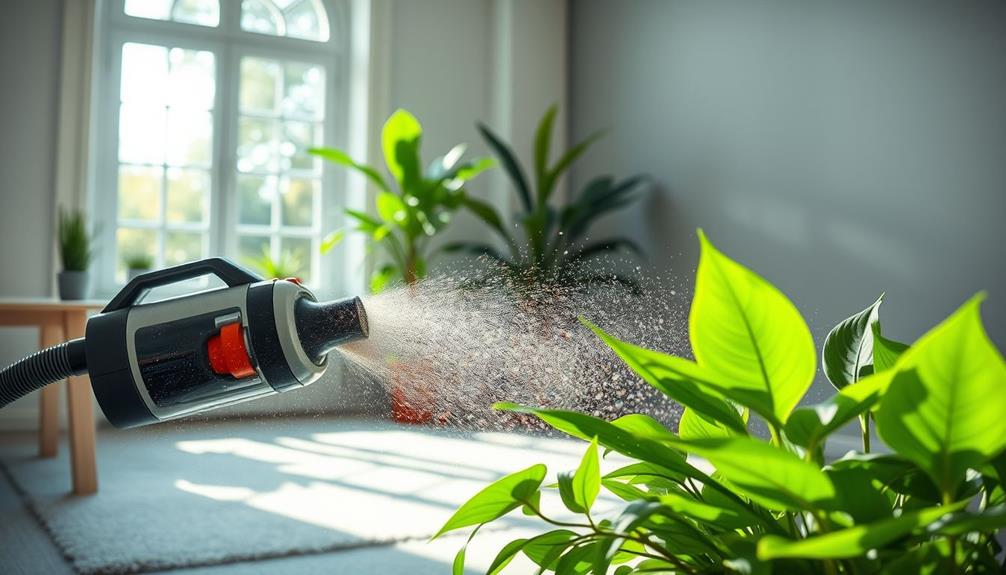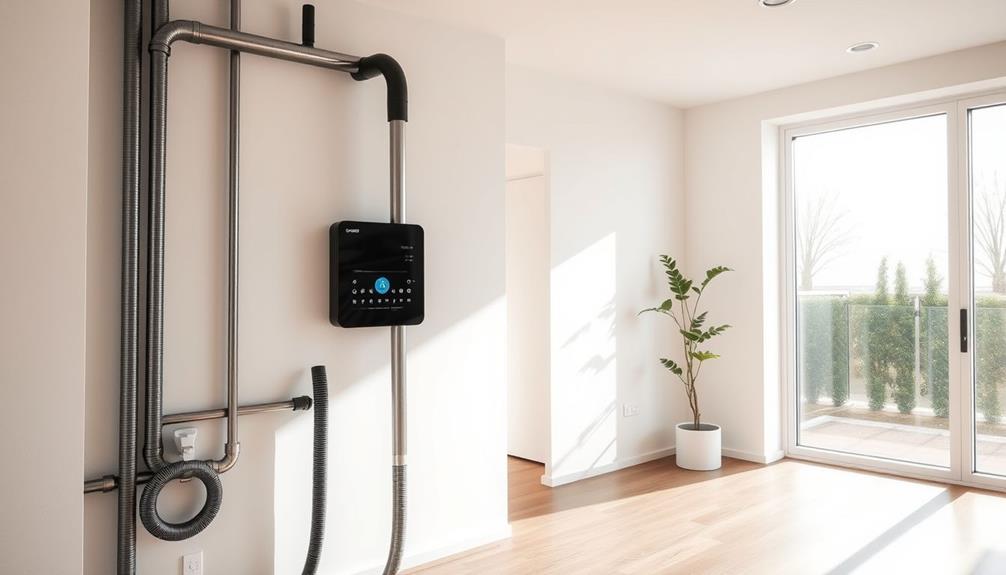If you have allergies, a good vacuum is your best friend. Using a **powerful vacuum** with a **HEPA filter** can capture 99.97% of allergens, such as dust mites and pet dander. By vacuuming regularly, you can reduce these irritants and improve your **indoor air quality**. Make sure to vacuum once or twice a week to keep allergens away. **Central vacuum systems** also help minimize dust recirculation, making them a great choice. Find a vacuum that suits your needs and see the difference. Stay tuned to learn more ways to improve your home environment for better health!
Key Takeaways
- High-performance vacuum cleaners with HEPA filters capture 99.97% of allergens, significantly improving indoor air quality for allergy sufferers.
- Regular vacuuming (once or twice a week) helps minimize dust mites, pet dander, and other harmful particles in the home.
- Central vacuum systems effectively trap allergens in a centralized unit, reducing recirculation and enhancing overall air quality.
- Self-emptying vacuum features prevent allergens from re-entering the air during disposal, promoting a cleaner indoor environment.
- Consistent use of advanced filtration systems in vacuums leads to healthier living spaces and reduced allergy symptoms.
Understanding Indoor Allergens
Indoor allergens are a notable concern for many, especially for those with asthma or allergies. If you're one of the over 27 million Americans affected, you know how essential it's to manage allergens like dust mites and pet dander.
Did you know that eight out of ten people are exposed to dust mites, while six out of ten encounter pet dander in their homes? These common sources can trigger respiratory issues when disturbed, especially in spaces with carpets, soft furnishings, or pets.
Utilizing the right vacuum cleaner, such as those with high-performance filtration systems, can greatly reduce the presence of these allergens in your home. To tackle indoor allergens effectively, you need a solid cleaning strategy. Regular vacuuming is important, but not just any vacuum will do.
It's crucial to use a vacuum equipped with a HEPA filter. This type of filter traps tiny particles, ensuring that dust mites and pet dander don't just get recirculated back into the air.
Keeping your air quality in check year-round is essential, as poor indoor air quality often worsens in winter due to heating systems and stale air. By understanding and managing these indoor allergens, you can create a healthier environment for yourself and your family.
Importance of Air Quality

Air quality directly affects your health and comfort at home.
When you maintain a clean environment, you're not just reducing allergens; you're also creating a space that promotes better breathing and overall well-being.
Implementing solutions like ozone air purifiers can effectively eliminate allergens and odors, further enhancing your indoor air quality.
Let's explore how improving air quality can enhance your home and health.
Health Impact of Air Quality
Maintaining a clean environment is essential for your health, especially when it comes to managing allergies and respiratory issues. Poor indoor air quality can greatly impact your well-being, often leading to respiratory problems, allergies, and even asthma.
In fact, over 27 million Americans suffer from asthma, with many experiencing worsening symptoms due to accumulated allergens like dust mites, pet dander, and mold spores. Utilizing a professional home cleaning service can help in reducing these allergens by ensuring thorough cleaning throughout your living space.
The Environmental Protection Agency (EPA) warns that indoor air can be 2 to 5 times more polluted than outdoor air. This pollution primarily stems from allergens and pollutants that gather in your living space.
Regular exposure to these triggers can lead to sneezing, congestion, and fatigue, making it essential to tackle the issue head-on. Improving indoor air quality is critical for reducing allergen levels and enhancing your overall respiratory health.
One effective way to achieve this is by investing in quality vacuum cleaners designed to capture allergens. By regularly vacuuming, you can minimize the presence of harmful particles in your home, providing relief and a better quality of life for yourself and your loved ones.
Don't underestimate the impact of clean air on your health—take action today!
Enhancing Home Environment
Creating a healthy home environment is crucial for your well-being, especially if you or a loved one suffers from allergies. Maintaining good indoor air quality can greatly reduce allergy symptoms. By using a vacuum equipped with a HEPA filter, you can effectively capture allergens like dust mites, pollen, and pet dander. This not only improves indoor air quality but also provides relief to those with respiratory issues.
To emphasize the importance of air quality, consider the following:
| Action | Benefit |
|---|---|
| Regular vacuuming | Captures 99.97% of particles, reducing allergens |
| Central vacuum systems | Traps allergens, enhancing air quality |
| Proper ventilation | Reduces moisture and mold growth |
The Environmental Protection Agency highlights that strategies like proper ventilation and regular cleaning are essential for controlling indoor allergens. By investing in a quality vacuum with a HEPA filter and maintaining low moisture levels, you can further enhance your home's air quality, making it a healthier space for everyone. Remember, a clean home means a healthier home!
How Vacuums Improve Air Quality

A clean home is essential for improving your indoor air quality, and using a vacuum equipped with a HEPA filter can make a notable difference. HEPA filters trap 99.97% of particles down to 0.3 microns, effectively capturing common indoor allergens like dust, pollen, and pet dander.
Additionally, maintaining proper hydration can play a role in alleviating allergy symptoms, as staying hydrated helps thin mucus and support overall respiratory health, a concept echoed in gout management strategies. When you regularly vacuum with a HEPA-filter vacuum cleaner, you considerably reduce allergen levels, which contributes to better air quality and helps alleviate allergy symptoms.
Central vacuum systems can further enhance your air quality since their power units are located away from living spaces. This design minimizes the recirculation of dust and allergens while you clean.
Additionally, advanced vacuum features, like self-emptying capabilities, guarantee that trapped allergens remain contained and don't re-enter your home's air.
To keep your indoor environment healthy, consistent vacuuming is key. Aim to vacuum at least once or twice a week; this habit is an effective strategy for controlling indoor allergens.
Features of Effective Vacuums

Choosing the right vacuum can greatly impact your efforts to manage indoor allergens. When you're shopping for a vacuum, look for features that enhance its effectiveness in trapping allergens and improving indoor air quality. For example, vacuums like the Bissell Pet Hair Eraser Vacuum offer self-cleaning brush rolls that reduce maintenance time while effectively capturing pet hair.
Here are some key features to reflect on:
- HEPA Filters: Confirm the vacuum has HEPA filters that can trap 99.97% of particles down to 0.3 microns, effectively capturing dust, pet dander, and pollen.
- Advanced Filtration Systems: Opt for models that prevent allergens from being released back into the air during vacuuming, maintaining a cleaner environment.
- High Allergen Capture Rates: Choose vacuums like the Shark NV360 or Dyson V11, which capture up to 99.99% of allergens, making them ideal for allergy sufferers.
- Self-Emptying Features: Reflect on vacuums with self-emptying capabilities to minimize manual disposal of collected dust and allergens, enhancing convenience.
Regular vacuuming with effective models will considerably reduce allergen accumulation on floors and surfaces.
Central Vacuum Systems Explained

Central vacuum systems offer an innovative solution for managing indoor allergens, making your home a healthier space. These systems operate quietly and efficiently, improving indoor air quality by trapping allergens like dust mites, pollen, and pet dander in a centralized unit, often located in garages or basements.
| Feature | Benefit |
|---|---|
| Quiet Operation | Reduces noise disruption |
| Effective Filtration | Captures small particles |
| Centralized Unit | Keeps allergens away from living areas |
| Durable Construction | Long-lasting investment |
| Professional Installation | Guarantees peak performance |
With a high-quality central vacuum system, you'll experience a cleaner environment that provides relief for allergies and asthma. These systems' advanced filtration systems greatly filter out harmful particles, enhancing your overall respiratory health. Regular maintenance further boosts their filtration capabilities, making certain they remain effective over time.
Investing in a central vacuum system not only elevates your indoor air quality but also promotes a healthier lifestyle by minimizing exposure to common allergens. Consider this solution if you're looking to improve your home environment and tackle allergies head-on.
Installation Tips for Central Vacuums

Installing a central vacuum system can greatly enhance your home's air quality, but it's important to approach the process thoughtfully. Here are some installation tips to guarantee you get the best performance and efficiency from your central vacuum system:
– Consider Professional Installation: Hiring a professional guarantees that the system is tailored to your home's unique layout, optimizing its performance.
Additionally, proper installation can help integrate smart technology features, enhancing overall efficiency and user experience, similar to how garage door openers improve home security.
- Timing Matters: If you're building a new home, install the system during construction for the best results. This allows proper placement of connectors and easier access.
- Look for Customizable Options: If you're retrofitting an existing home, explore customizable features that suit your specific needs and enhance indoor air quality.
- Optimize Power Unit Location: Place the power unit in a garage or basement to improve the filtration of allergens and small particles, contributing to a cleaner indoor environment.
Maintenance for Optimal Performance

To keep your vacuum running at its best, regularly change the filters to guarantee it effectively traps allergens. This is especially important for households with pets, as cat behavior and emotional attachment can lead to increased shedding and dander.
Don't forget to schedule deep cleaning for components like brushes and belts every six months, as this can enhance your vacuum's performance.
Regular Filter Changes
Maintaining your vacuum's filter is essential for ideal performance and effective allergy management. Regular filter changes are vital, as clogged filters can reduce suction power and allow allergens to escape back into the air, worsening allergy symptoms.
To support your overall well-being during allergy season, consider incorporating stress management techniques to further enhance your indoor air quality. Additionally, mindful eating can also play a role in strengthening your immune system, making it easier to combat allergy symptoms.
To keep your indoor air quality high, follow these simple tips for filter maintenance:
- Change HEPA filters every 6 to 12 months to guarantee they trap 99.97% of particles as small as 0.3 microns.
- Check for indicator lights on your vacuum that signal when it's time to change the filter.
- Follow the manufacturer's guidelines to prolong your vacuum's lifespan and efficiency.
- Monitor dust levels in your home; if they rise, it might be time to check your filters.
Scheduled Deep Cleaning
A regular schedule for deep cleaning can make a noticeable difference in managing allergens in your home. By committing to scheduled deep cleaning with a vacuum that features HEPA filters at least once or twice a week, you can greatly reduce allergens like dust mites, pet dander, and pollen.
Incorporating key strategies for a healthy lifestyle into your cleaning routine further enhances your indoor environment. This proactive approach directly improves your indoor air quality, helping to alleviate allergy symptoms.
It's essential to maintain your vacuum system by regularly changing the filters and emptying the dust containers. This not only boosts suction power but also guarantees effective allergen capture, preventing those irritants from re-entering the air you breathe.
Your deep cleaning routine should focus on vacuuming carpets, rugs, and upholstered furniture to eliminate the allergens that accumulate over time.
Consider utilizing advanced vacuum features, such as self-emptying capabilities and specialized attachments for pet hair. These can streamline your cleaning process and improve overall effectiveness against allergens.
Incorporating scheduled deep cleaning into your maintenance routine not only promotes better indoor air quality but also contributes to improved respiratory health, particularly for those who suffer from allergies and asthma.
Customer Experiences and Testimonials

Many customers share their impressive experiences with vacuum systems designed for allergy relief, particularly those featuring HEPA filters. These systems have transformed their homes, greatly reducing allergens and improving indoor air quality.
Understanding the impact of environmental factors on health, especially in relation to narcissistic abuse effects, many users report a noticeable decrease in dust mites and pet dander, leading to fewer allergy and asthma symptoms.
Customers appreciate the hassle-free installation process, which makes adopting these vacuum systems easy and quick. Positive feedback highlights the expertise of store staff, aiding customers in selecting the right vacuum for their allergy management needs.
Numerous customers express their loyalty and willingness to recommend these products, validating their investment in better indoor air quality.
These customer experiences underscore the importance of choosing the right vacuum systems for allergy relief. Whether you're battling allergens head-on or simply aiming for a cleaner home, investing in a quality vacuum can make a considerable difference in your indoor air quality and overall comfort.
Community Support for Allergy Management

Community support networks play an essential role in allergy management, offering valuable resources and connections for individuals seeking relief from allergens. Engaging with local organizations can provide you with critical information about managing your allergies effectively. Workshops and seminars often focus on educating residents about common allergens and strategies for improving indoor air quality.
Accessing resources like the Asthma and Allergy Foundation of America (AAFA) can empower you with knowledge about asthma and allergy management, enabling you to take control of your environment. Support groups within your community foster connections with others facing similar allergy challenges, allowing you to share tips and emotional support that can make a significant difference in your daily life.
Additionally, local businesses, such as vacuum retailers, frequently participate in community outreach. They offer expert advice on products that help improve indoor air quality and reduce allergens, making it easier for you to maintain a healthier home.
Additional Resources for Allergy Relief

While steering through the challenges of allergies, you can access a variety of additional resources that can greatly improve your quality of life.
From expert guidance to effective tools, these resources can help you manage allergens and enhance your indoor air quality.
- Asthma and Allergy Foundation of America (AAFA): They offer educational materials and support networks for allergy management.
- Air purifiers with HEPA filters: These can help reduce airborne allergens by capturing 99.97% of particles down to 0.3 microns, considerably improving air quality.
- Regular HVAC filter changes: Keeping your air filters clean is essential; dirty filters can recirculate dust and allergens, worsening your symptoms.
- Environmental Protection Agency (EPA) guidelines: Follow their recommendations for maintaining low humidity levels (30-50%) to prevent mold growth, a common indoor allergen.
Always seek medical advice if your symptoms persist or worsen.
By leveraging these resources, you can create a healthier living space and manage your allergies more effectively.
Frequently Asked Questions
Does Vacuuming Improve Indoor Air Quality?
Yes, vacuuming definitely improves indoor air quality.
When you regularly vacuum your floors and carpets, you're capturing dust, pet dander, and other allergens that settle on surfaces. This reduces the chances of these particles becoming airborne, which can trigger allergy symptoms.
Does Vacuuming Help With Allergies?
Yes, vacuuming helps with allergies.
When you vacuum regularly, you're removing dust, pet dander, and pollen from your home, which can trigger allergy symptoms.
Using a vacuum with a HEPA filter captures up to 99.97% of airborne allergens, ensuring cleaner air.
Make it a habit to vacuum carpets and rugs weekly, as these areas can harbor allergens.
How Often Should You Vacuum Carpet if You Have Allergies?
If you have allergies, you should vacuum your carpets at least once or twice a week.
High-frequency vacuuming helps reduce allergen buildup, like dust mites and pet dander. During allergy seasons, consider vacuuming even more often, as pollen can accumulate quickly.
Using a vacuum with a HEPA filter can trap tiny particles, preventing them from being released back into the air.
This routine will greatly enhance your indoor air quality and alleviate allergy symptoms.
What Is the Most Effective Way to Improve Indoor Air Quality?
You might think that just opening windows can freshen up your indoor air, but that's not always true.
The most effective way to improve indoor air quality involves a combination of strategies. Start by using air purifiers with HEPA filters, keep humidity below 50%, and regularly change air filters in your HVAC system.
Incorporate a consistent cleaning routine and seal windows to limit outside allergens. These steps can create a healthier indoor environment for you.
Conclusion
By choosing the right vacuum, you can greatly reduce indoor allergens and breathe easier at home. Did you know that vacuuming can remove up to 80% of dust mites and their droppings from carpets? With features like HEPA filters and regular maintenance, your vacuum can be a powerful ally in improving air quality. So, take control of your indoor environment and invest in a vacuum that suits your needs; your health and comfort will thank you!









